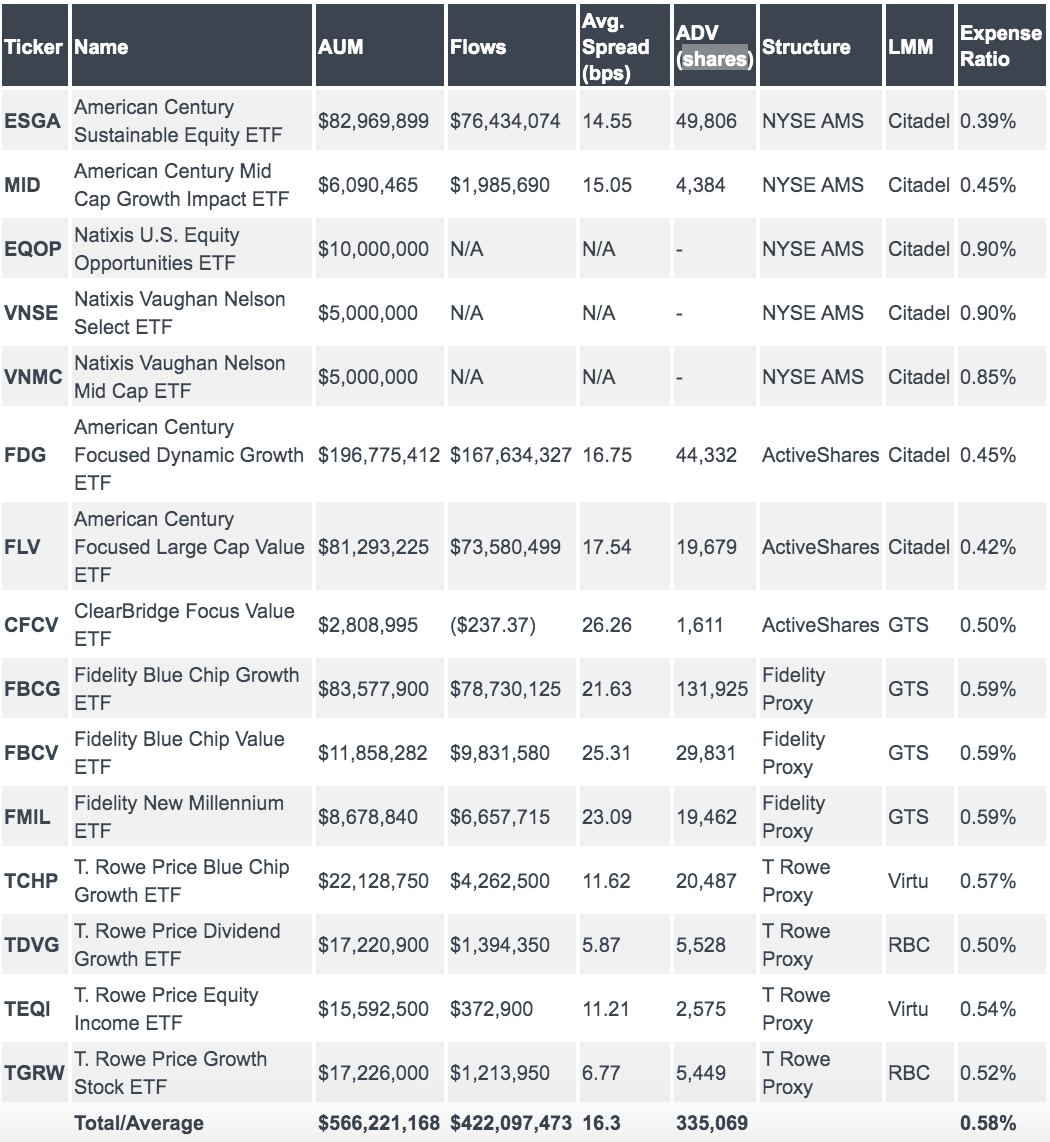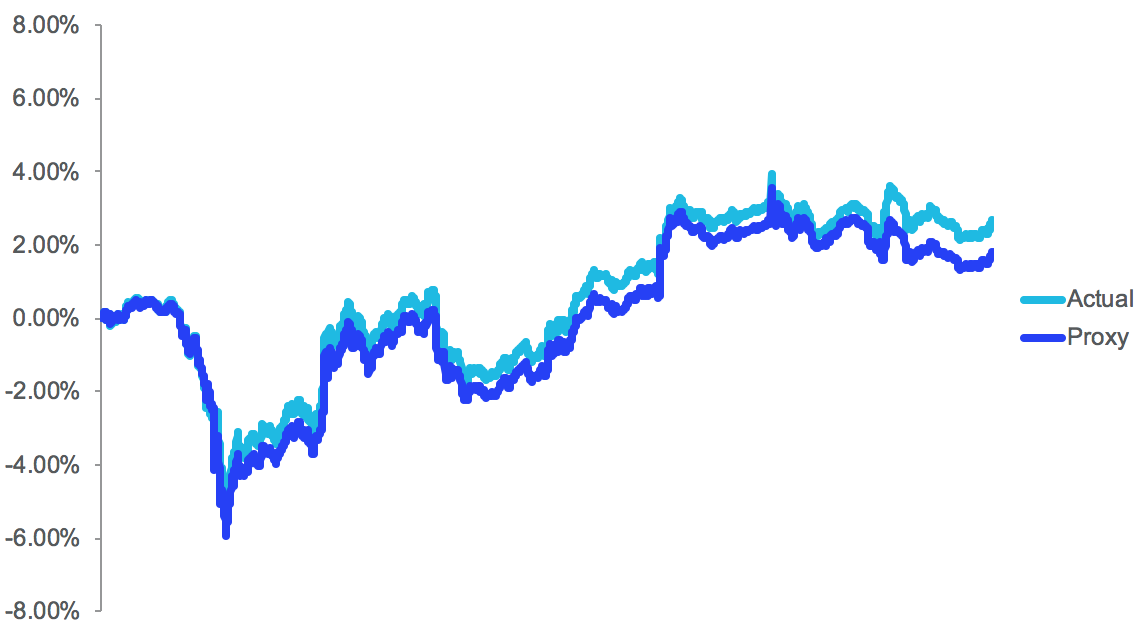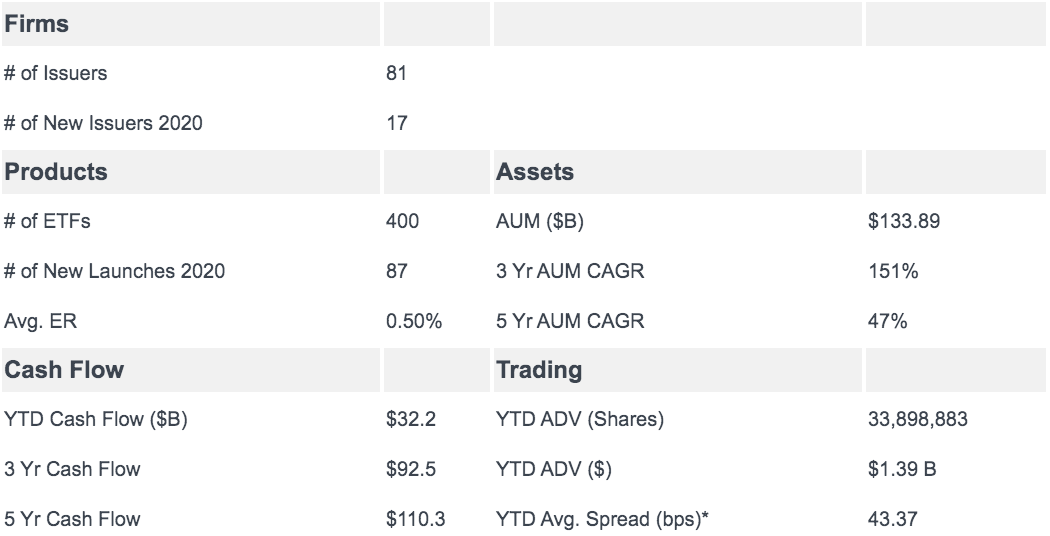More issuers join the semi-transparent market
September 17, 2020
Natixis joins the semi-transparent market, Invesco and others file
Natixis Investment Managers listed three new ETFs on NYSE Arca on September 17, 2020, becoming the fifth issuer to enter the semi-transparent ETF market. Natixis’s three ETFs leverage the NYSE’s Actively Managed Solution (AMS) structure and are modeled after successful mutual funds run by the portfolio teams at Harris Associates, Loomis Sayles and Vaughan Nelson.

Source: Factset & NYSE Internal Database and Consolidated Tape Statistics as of 9/11/2020
*Simple average
**Data unavailable at the time of publication
Invesco, which has both a pending filing with the SEC for its own structure relief and a recently signed agreement with Fidelity, clarified its initial intentions to launch four ETFs using the Fidelity structure in an SEC filing on September 9, 2020. AdvisorShares also filed to list two ActiveShares products on the NYSE, which will be sub-advised by ThinkBetter. We are seeing a strong product filing start for the month of September and the close of the third quarter. For those keeping tally, there are now ~25 active, semi-transparent ETFs filed with the SEC across nine asset management firms.
NYSE/Natixis file for additional basket flexibility in NYSE AMS
On August 31, 2020, the NYSE and Natixis Investment Managers filed with the SEC for additional basket flexibility within the NYSE AMS. If approved, Natixis and future asset managers using the NYSE AMS will be able to construct creation/redemption baskets that differ from the daily proxy portfolio. This will improve the operational efficiency of the AMS structure and potentially reduce costs for sponsors. The full filing can be found here.
NYSE fles for generic listing standards for semi-transparent ETFs
The NYSE became the first exchange to file for generic listing standards for semi-transparent ETFs on August 31, 2020. If approved, asset managers launching such ETFs will no longer be subject to approval on a one-off basis and individual Exchange rule filings for each product won’t be required. This will accelerate time-to-market and reduce the associated costs with launching active, semi-transparent ETFs. The full filing can be found here.
Analyzing the NYSE Semi-Transparent Solution: Building a Proxy in Small Cap
Objective: Use a three-day lagged portfolio and mask ~10-20% of the strategy by excluding any symbol that has portfolio level trading activity from the daily proxy.
Investment Strategy: Small cap blend strategy with ~50 names in the portfolio.
Constraints: Gradually moved from masking ~10% of holdings to ~20% of holdings, limited proxy to 55 names selected from Russell 2000.
Names Restricted: VEEV (Buy: 5.34%), PRLB (Sell: 2.98%), ABMD (Sell: 3.05%), DDOG (Buy: 4.71%), VSLR (Buy: 1.12%), PRO (No Trade: 1.63%).
Time Frame: 7/13-8/14/2020
In previous notes, we have examined the efficiency of building proxy baskets leveraging the NYSE AMS with both moderate and low overlap strategies in a large cap growth portfolio. With a small cap strategy there is naturally more stock specific risk, which can be amplified by market volatility as observed over the sample period. Despite these new headwinds, the process developed with Axioma demonstrates that efficient proxy building can occur regardless of market capitalization.
NYSE Actual vs. Proxy Tick by Tick Performance
(7/13/2020-8/14/2020)


*% weight of names in actual portfolio and excluded from daily proxy
**Portfolio overlap is the common weight between the actual portfolio (actual holdings not disclosed to public) and proxy portfolio (created daily and disclosed to public as create/redeem basket)
The three-day lagged portfolio demonstrates the flexibility of the NYSE AMS solution. Though such a constraint should lead to greater tracking error, the efficiency of the Axioma optimizer minimizes the gap and results in a proxy portfolio that consistently tracks the actual fund. During the observed period, the 30-day average tracking error was 0.49% with a range between 0.00% and 1.86%.
For additional details on this exercise or to run a sample portfolio, contact [email protected]
Active ETF Stat Pack
